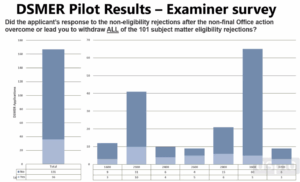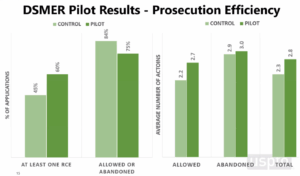On June 18, 2025, the United States Patent and Trademark Office (USPTO) hosted an informational call to share the results of a study on the Deferred Subject Matter Eligibility (DSMER) Pilot Program, three years after its launch. Broadly, the study found that while deferring applicant responses to Section 101 subject-matter-eligibility rejections[1] did not improve examination efficiency, it did lead to some applications being allowed without ever requiring applicants to address eligibility rejections. The program and its results are discussed in more detail below.
Overview of the Program
In January 2022, the USPTO launched the DSMER Pilot Program[2] to assess how deferring applicant responses to Section 101 subject-matter-eligibility rejections would affect examination efficiency and patent quality. The program was implemented in response to a letter from Senators Thom Tillis and Tom Cotton asking the USPTO to explore a sequenced approach to patent examination. Under this approach, applicants would first address rejections under non-eligibility grounds such as Section 102 (novelty), Section 103 (obviousness), and Section 112 (written description, enablement, and definiteness) [3] before being required to respond to subject-matter-eligibility rejections under Section 101. The rationale was that amending the claims to comply with Sections 102, 103, and 112 could also bring the claims into compliance with Section 101 so that a subject-matter-eligibility rejection would no longer be necessary.
The USPTO invited applicants to participate in the program from February 1 through July 30, 2022. To qualify, an application had to receive rejections under both eligibility and non-eligibility grounds. Examiners would issue a first office action identifying both types of rejections and inviting applicants to participate in the pilot. Applicants who opted into the program were required to respond to all non-eligibility rejections but were permitted to defer their response to eligibility rejections until either: (1) a final office action was issued; or (2) until all non-eligibility rejections had been overcome and an eligibility rejection remained.
Preliminary Results of the Program
The USPTO compiled preliminary statistics once a majority of the participating applications had reached allowance or abandonment. In approximately 22% of participating applications, applicants were able to overcome or prompt the withdrawal of all subject-matter-eligibility rejections by responding only to non-eligibility rejections.[4] This outcome supports the premise that eligibility issues may, in some cases, be resolved naturally through claim amendments addressing other statutory requirements. However, for the majority of participating applications, eligibility rejections were maintained and required applicant responses later in prosecution. Reproduced below is the USPTO’s summary of the pilot program’s results.[5]

The study also determined that participating applications required more office actions on average to reach allowance when compared to non-participating applications, resulting in longer prosecution timelines. Additionally, requests for continued examination were filed at a higher rate in participating applications, which further contributed to delays in prosecution.[6] Overall, as shown below,[7] preliminary results of the pilot program suggest that deferring responses to Section 101 subject matter eligibility rejections may not improve examination efficiency, as initially hoped, and may actually extend prosecution timelines.

Ongoing Evaluation of the Program
The USPTO has stated that analysis of the DSMER pilot program is ongoing, as not all participating applications have reached allowance or abandonment. Further information about the DSMER pilot program can be found on the USPTO’s website here.
[1] See 35 U.S.C. § 101
[2] See 87 Fed. Reg. 776 (Jan. 6, 2022).
[3] See 35 U.S.C. § 102, 35 U.S.C. § 103, and 35 U.S.C. § 112
[4] See “DSMER Pilot Results – Examiner survey”
[5] PowerPoint Presentation from June 18, 2025 PTO Webinar “USPTO Hour: Congressional Inquiries Regarding Patent Topics”
[6] See “DSMER Pilot Results – Prosecution Efficiency”
[7] PowerPoint Presentation from June 18, 2025 PTO Webinar “USPTO Hour: Congressional Inquiries Regarding Patent Topics”

